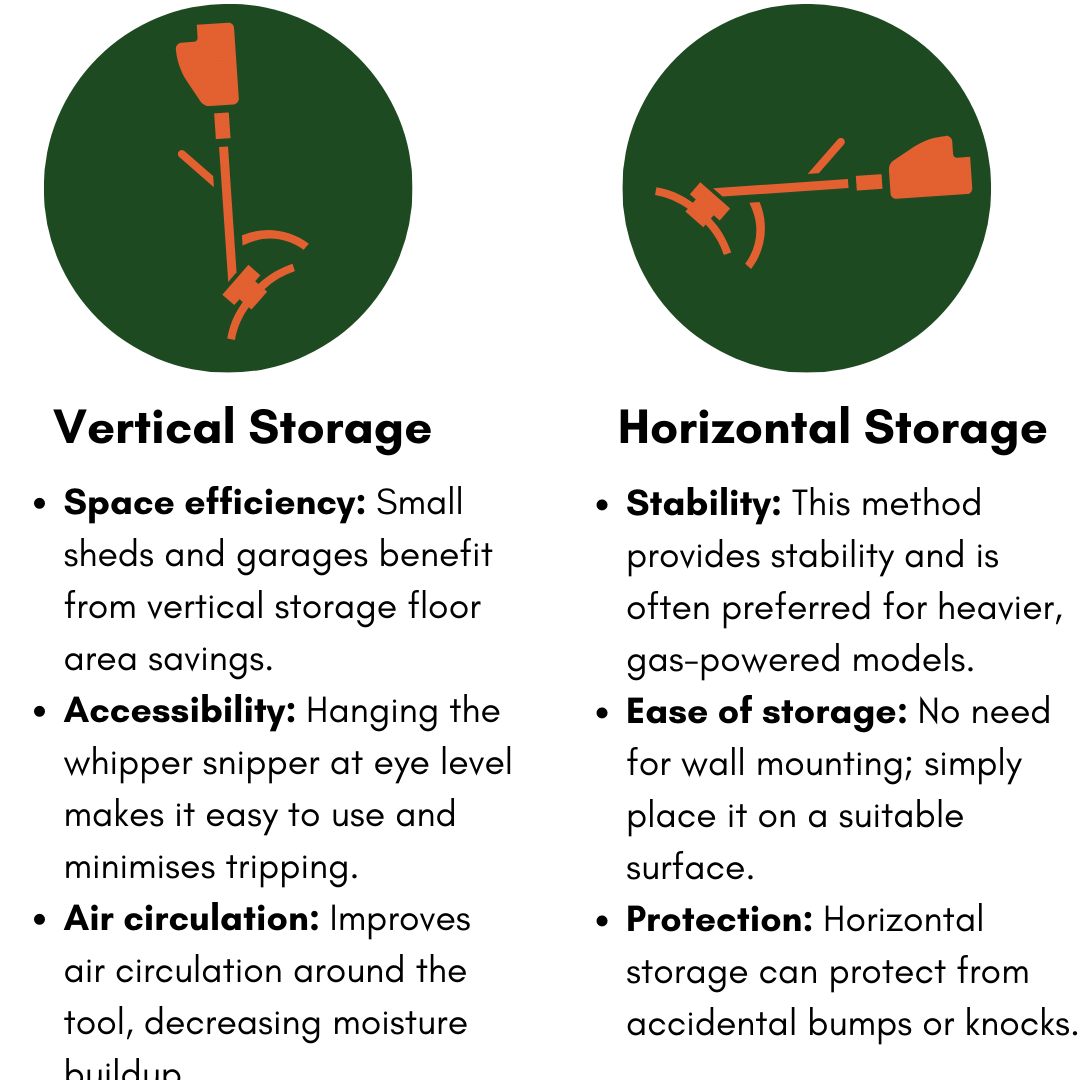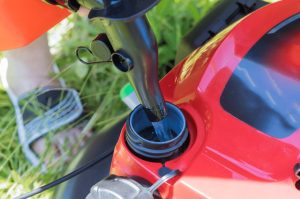Storing a whipper snipper properly is more than simply keeping your shed tidy; it’s about extending the life and efficiency of one of the most versatile tools in an Australian gardener’s inventory. We all know that using a whipper snipper is vital for preserving those sharp lawn edges and battling overgrown grass, whether you’re a professional landscaper or a weekend garden warrior.
But what happens if we don’t properly care for our whipper snipper? Improper storage can cause mechanical difficulties, a decline in performance, and even a decrease in the tool’s lifespan.
That’s why we’ve compiled this complete guide to storing a whipper snipper. So, read on to get the best tips to make your whipper snipper last the long run!
Different types of whipper snippers
Whipper snippers are available in various models, each with its own capabilities and storage requirements. Understanding these distinctions is critical for properly storing your whipper snipper, preserving its performance and longevity. Let’s look at the three primary varieties of whipper snippers: petrol, electric, and battery.
Gas-powered whipper snippers
Gas-powered whipper snippers are well-known for their durability and ability to handle heavy-duty jobs.
Here’s what you need to know about storing them:
- Fuel management: Drain or stabilise fuel before storing it to prevent degradation.
- Spark plug care: To prevent corrosion, check and clean spark plugs regularly.
- Ventilation: Store in a well-ventilated area to avoid fumes.
Electric whipper snippers
Electric whipper snippers are popular because they are simple to operate and require little upkeep.
In our experience, here’s an effective way to store them:
- Cord care: Keep the power cord neatly coiled and undamaged.
- Dry storage: Avoid electrical concerns by keeping the area dry.
- Space-saving: Many electric whipper snippers can be wall-hung, conserving floor space.
Battery-operated whipper snippers
Cordless battery-operated models are convenient due to their cordless functionality.
Some storage considerations include:
- Battery maintenance: Store the battery separately in a cool, dry area.
- Charging: To extend battery life, follow manufacturer charging and storage instructions.
- Compact storage: Many battery-operated whipper snippers can be wall-mounted like electric ones.
Vertical vs horizontal storage
The direction of your whipper snipper is important while storing it. Both vertical and horizontal storage has advantages and disadvantages, and the best option relies on your available space, the type of whipper snipper, and personal preferences.

Vertical storage
Vertical storage of a whipper snipper, usually by hanging it on a wall, is a popular solution that offers various benefits:
- Space efficiency: Small sheds and garages benefit from vertical storage floor area savings.
- Accessibility: Hanging the whipper snipper at eye level makes it easy to use and minimises tripping.
- Air circulation: Improves air circulation around the tool, decreasing moisture buildup
Vertical storage, on the other hand, necessitates careful design and implementation. Here’s a comprehensive walkthrough on how we vertically store our whipper snippers.
- Choose the right spot: Choose a wall without direct sunlight or wetness. Place it near but not in high-traffic areas.
- Use proper hooks: Buy heavy-duty tool wall hooks. They should support whipper snipper weight.
- Check the orientation: Some experts propose hanging gas-powered machines with the engine up to prevent oil leaks.
- Secure the whipper snipper: Secure it so it won’t fall if bumped.
- Safety precautions: Cover the cutting head and use safety guards.
In our opinion, vertical storage saves space and promotes the tool’s longevity by preventing undue pressure on certain parts.
Horizontal storage
Another potential alternative is horizontal storage, or setting the whipper snipper flat on a shelf or rack; this offers many advantages such as:
- Stability: This method provides stability and is often preferred for heavier, gas-powered models.
- Ease of storage: No need for wall mounting; simply place it on a suitable surface.
- Protection: Horizontal storage can protect from accidental bumps or knocks.
Whipper snippers can be stored horizontally in the following way:
- Choose a stable surface: A weight-bearing shelf or rack is needed.
- Positioning: To avoid tool stress, align the whipper snipper’s engine and cutting head.
- Avoid crowding: Give the whipper snipper space to prevent injury.
- Safety measures: As with vertical storage, cover the cutting head and engage all safety mechanisms.
Ultimately, we find that horizontal storage is often best for gas-powered models, as it prevents any potential fluid leakage and provides easy access for maintenance.”
How do you store a whipper snipper cord?
A whipper snipper cord, or a cutting line, is an essential tool component that needs particular storage. Proper cable storage keeps it tangle-free, shapely, and ready to use.
When storing a whipper snipper cable, we recommend implementing the following practices:
- Inspect and clean: Check and clean for wear and debris.
- Wind it neatly: In manual feed models, wind the cable around the spool or align it.
- Use a cord holder: To avoid tangling, utilise a cord holder for extra cutting line.
- Properly store: Avoid chemicals and sharp bends in a cold, dry environment.
- Follow manufacturer instructions: Consider cord type and storage requirements.

Seasonal storage tips
Storing your whipper snipper following the changing seasons is critical to keep it in peak condition all year. Because different weather conditions might have varying effects on the tool, here’s a guide to assist you in handling seasonal storage:
Summer care
Avoiding heat exposure is critical when keeping a whipper snipper, so keep it out of direct sunlight to avoid overheating and potential plastic damage. Regular maintenance, such as cleaning and inspection, is also essential to ensure its longevity, as you’ll be using the whipper snipper more frequently throughout the summer.
Furthermore, it is critical to store the whipper snipper away from sprinkler systems or other areas prone to water exposure, as this can assist in avoiding rusting and further water-related damage.
Autumn preparation
Cleaning your whipper snipper thoroughly in Autumn is an important step in its upkeep. We recommend eliminating any debris, such as moist leaves and grass; this will help avoid mildew and rust.
In addition, after a busy summer, evaluate the cutting line for wear and replace it if necessary to ensure peak performance. To keep the whipper snipper running smoothly, apply lubricant to the moving parts, aiding their movement and extending the tool’s life.
Winter storage
If you wish to store a gas-powered whipper snipper during winter, drain the fuel or add a stabiliser to prevent degradation. We recommend keeping the whipper snipper in a dry, protected space to avoid freezing damage.
Finally, protecting the cutting head from dust and moisture helps preserve it in top shape for future usage.
Spring readiness
As the growing season approaches, inspecting your whipper snipper for winter damage and giving it a tune-up to prepare it for the chores ahead is critical. Make sure the batteries in your battery-powered whipper snipper are completely charged and ready to go.
Lastly, it’s a good idea to test the whipper snipper’s operation momentarily to ensure it’s in good working order and ready for the spring tasks. This proactive strategy will help you avoid surprises and ensure a successful gardening season.
Creative and budget-friendly storage solutions
Storing your whipper snipper does not have to be expensive or difficult. With a little imagination and DIY flair, you can construct excellent storage solutions that are both cost-effective and functional.
1. Backing board with tool holders
- Description: Create a custom holder using a backing board and simple store-bought tool holders that can be mounted on the wall.
- Benefits: Affordable, customisable, and space-saving.
- Resources: Custom-mounted board tutorial.
2. Repurposed pallet rack
- Description: Transform an old wooden pallet into a horizontal storage rack for your whipper snipper.
- Benefits: Eco-friendly, rustic look, and virtually free if you have an old pallet.
- Resources: Pallet rack repurposing inspiration.
3. Ceiling-mounted hooks
- Description: Utilise ceiling space by installing heavy-duty hooks to hang your whipper snipper vertically.
- Benefits: Great for small spaces and relatively inexpensive.
- Resources: Heavy-duty ceiling hook product.
4. Garden tool organiser
- Description: Purchase or build a garden tool organiser that can hold various tools, including the whipper snipper.
- Benefits: Keeps all garden tools organised in one place, a budget-friendly option.
- Resources: Garden tool organiser products.
5. Bungee cord storage
- Description: Use bungee cords to create a flexible and secure storage solution on a garage wall.
- Benefits: Adaptable to different tool sizes, low cost, and easy to install.
- Resources: Bungee cord storage tutorial.
Avoiding common storage mistakes
Proper whipper snipper storage is critical for preserving its function and longevity.
However, it is all too easy to make certain basic storage blunders that can cause extra wear and strain.
Here’s a list of common blunders, as well as answers and preventative steps to assist you in avoiding them:
Storing in direct sunlight
- Mistake: Leaving the whipper snipper in direct sunlight can cause overheating and damage plastic parts.
- Solution: Store in a shaded, cool area.
- Preventative measure: Choose a storage spot away from windows or areas with prolonged sun exposure.
Ignoring fuel management (gas models)
- Mistake: Leaving fuel in a gas-powered whipper snipper during extended storage can cause degradation.
- Solution: Drain the fuel or add a stabiliser.
- Preventative measure: Make fuel management part of your regular maintenance routine.
Storing without cleaning
- Mistake: Storing the whipper snipper without cleaning can lead to rust and corrosion.
- Solution: Clean thoroughly before storing.
- Preventative measure: Make cleaning a habit after each use.
Improper cord storage
- Mistake: Storing the cutting line improperly can lead to tangling and weakening.
- Solution: Wind the cord neatly or use a cord holder.
- Preventative measure: Regularly inspect the cord and replace it if needed.
Ignoring seasonal needs
- Mistake: Failing to adapt storage methods to different seasons can cause weather-related damage.
- Solution: Follow seasonal storage guidelines.
- Preventative measure: Plan seasonal maintenance and storage adjustments.
Overcrowding the storage area
- Mistake: Storing the whipper snipper in a crowded area can lead to accidental damage.
- Solution: Provide enough space around the tool.
- Preventative measure: Organise your storage area and consider creative storage solutions.
Failing to cover cutting head
- Mistake: Exposing the cutting head can lead to dust accumulation and potential injury.
- Solution: Use a protective cover. We recommend checking out our guide on different whipper snipper head types to ensure you get the right guard.
- Preventative measure: Make covering the cutting head part of your storage routine.
Final thoughts on whipper snipper storage
Understanding different varieties and seasonal demands, avoiding typical blunders and exploring inventive storage methods makes a major difference when storing your whipper snipper.
At the end of the day, taking the time to preserve your whipper snipper properly demonstrates your dedication to your tools and yard. Accept these guidelines, and your whipper snipper will serve you well for many years!
FAQs
How can I properly clean my whipper snipper before storing it?
Turn off your whipper snipper and use a soft brush or cloth to remove debris from the cutting head. Use a moderate detergent and water for the dirt, then thoroughly dry the instrument. Regular cleaning before storage aids in the prevention of corrosion and the preservation of performance.
Is it safe to store a whipper snipper with fuel in the tank?
Short-term storage of a whipper snipper with fuel in the tank is normally safe but for extended storage, either empty the fuel or add a stabiliser. Leaving petrol in the tank for extended periods can create deterioration and engine difficulties.
Can I store my whipper snipper outdoors, and what precautions should I take?
Outdoor storage of a whipper snipper is conceivable. Still, measures must be taken, such as keeping it in a weatherproof shed or beneath a protective cover to protect it from moisture and high temperatures. Maintaining the tool’s condition will also benefit from sufficient ventilation and avoiding direct sunlight.






